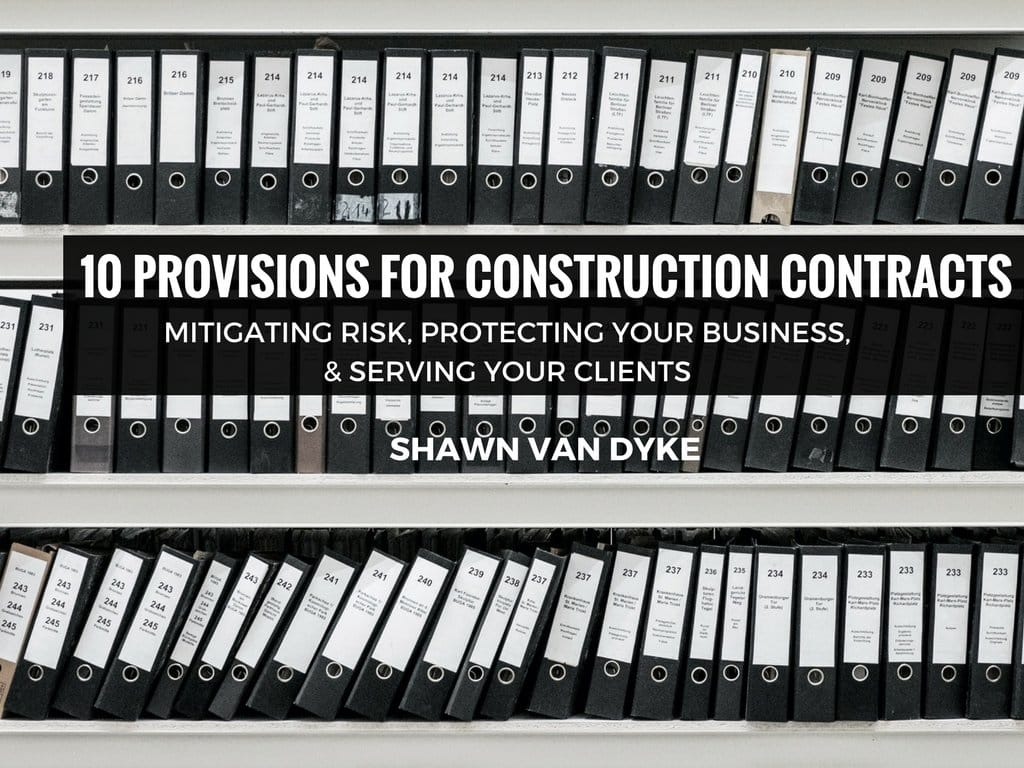Built to Build: Blog
10 PROVISIONS FOR CONSTRUCTION CONTRACTS

There are many types of construction contracts that can achieve the goals listed above, and you should consult an attorney for the best contract structure that works for your construction business.*
*The items listed in this article should not be considered legal, accounting or professional advice, but are strictly provided here as opinion. You should consult a qualified and licensed professional in your area or jurisdiction for more information regarding this subject.
In this article on FineHomebuilding.com, I detail the 10 provisions you should include in your standard construction contract.
10 PROVISIONS IN YOUR CONSTRUCTION CONTRACT
The following list is in no way a comprehensive list of provisions for a construction contract, but these provisions should be included in your construction contracts as a minimum requirement.
1. LENGTH OF CONTRACT
Many contractors of often ask me:
“How long (how many pages) does my contract need to be?”
Answer: Your construction contract should be long enough to mitigate your risk and protect your business and your clients according to the proposed scope of work.
For service and maintenance work or other small projects, you may be able to accomplish this risk mitigation in a one or two-page work order.
For larger, more complex projects you will need a longer, more comprehensive contract that includes many, if not all, of the items listed below.
When in doubt, the longer the better.
2. DEFINE THE PARTIES INVOLVED
This may seem pretty basic, but you need to establish who the “CONTRACTOR” is and who the “OWNER” is for every project.
Some states require that the legal name of the business is displayed and defined on the first page of the contract. This includes the business entity – LLC, INC, LTD, etc.
You may also be required to list the address of the business along with license number and other contact information.
The “OWNER” of the project defines the person or entity that is responsible for meeting the stipulations of the contract.
3. NOTICES REQUIRED BY THE STATE
Your contract should include all notices that may be required by your state or local jurisdiction. Examples of these types of notices could include listing the lien laws of the state, rights to rescind clauses, and the limit of deposits.
Consult an attorney in your area regarding your state’s required notices.
4. PROJECT SCOPE
The project scope defines the detailed list of items that the contractor will perform or have performed by its subcontractors.
The project scope should always include a reference to the construction documents from which the project scope was developed. The referenced construction documents can be attached to the contract as Exhibits or Appendices as described in the contract.
For example:
“The Project Scope, see Exhibit A, is based on the Plans and Specifications (dated Jan. 1, 2017), see Exhibit B.”
5. CONTRACT PRICE
The contract price should be defined according the structure of the contract. For a Lump Sum contract, the contract price is usually one number. For Cost Plus or Time and Material contracts, the contract price is usually determined by a formula related to the actual costs of performing the scope of work.
6. PAYMENT SCHEDULE
The payment schedule informs the Owner of when she can expect to be billed for the services performed and when the payment for the invoices are due to the contractor. The payment schedule may also list the billing rates for hourly work beyond the scope of work for minor changes.
For example:
A standard payment schedule may be defined like this:
Initial Deposit – 30% – Upon Execution of Construction Contract
Progress Payment #1 – 20% – Upon Commencement of Project Scope
Progress Payment #2 – 10% – Upon Completion of Rough-In of MEP Scope
Progress Payment #3 – 25% – Upon Completion of Drywall
Progress Payment #4 – 10% – Upon Substantial Completion
Final Payment – 5% – Upon Final Completion
7. CHANGE ORDERS
Every contract should include language concerning the creation, approval, and payment of change orders.
Describe in your contracts why and how a change order will be created, who is responsible for approving the change order, and when the payment of the change order is due.
Normally, I recommend that all payments for change orders are due prior to commencement of the work for which the change order involves. This ensures that the contractor is not financing the cost of the change order.
8. INSURANCE REQUIREMENTS
In order to establish trust with your clients, you want to list your insurance coverages. Providing proof of insurance to your clients is a great way to show them that they are dealing with a professional organization.
Some projects may require additional insurance coverages, and these additional coverages may come at a cost to the owner. These additional costs need to be defined in the contract.
9. OTHER TERMS AND CONDITIONS
This section of the contract is your “Catch-All” section. Items to include or define in this section of the contract may include:
COMMUNICATION PROTOCOL – Define the person who has the authority on the job site to approve changes in the scope of work, schedule, or design decisions and the manner in which any changes should be communicated.
EXCLUSIONS – Items specifically not included in the Scope or Work.
ALLOWANCES – Items whose price may vary depending final selection. Make sure to define whether the price for the allowances are included in the contract price or excluded from the contract price.
UPGRADES – Items that the owner may choose to upgrade at some point after the execution of the construction contract.
WARRANTY – List the warranties that your construction company provides for the work performed. Your contract may also include any warranty information from product manufacturers that the owner may need to maintain.
10. TERMINATION OF SERVICES
The client may need to fire you if you don’t perform your job as a contractor. Your contract should state the procedure for doing so. Your contract should also include the procedure for you firing your client.
The termination of services clause should detail the notice period, payment reconciliation terms, and settlement of any legal or other fees associated with termination.
At a minimum, the provisions listed above should appear in your construction contract. Consult with a qualified attorney in your area to help you develop the proper contracts for your business or review your existing contracts.
This will be money well spent.
If you have ever been involved in a legal dispute involving your construction business, then you know that this statement is true:
“The person with the most paperwork wins.”
Start winning the paperwork game with a comprehensive construction contract that mitigates your risk, protects your business and serves your client.
If you want to streamline your construction business and DOUBLE your profits next month…
download my FREE book: The Paperwork Punch List

